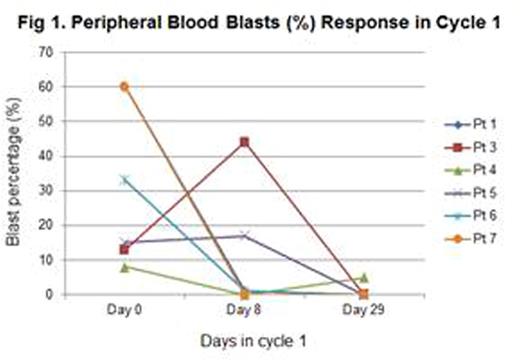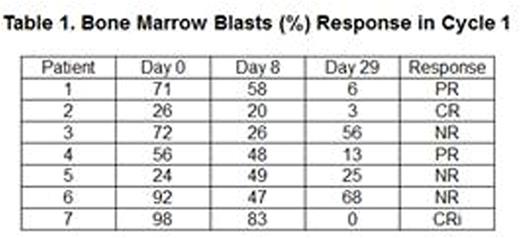Abstract
Background: Crenolanib is a novel type I pan-FLT3 inhibitor, which inhibits both FLT3-ITD, as well as FLT3 tyrosine kinase domain (TKD) activating mutations. Combination of crenolanib (Type I) and sorafenib (Type II) has been shown to have synergistic apoptotic effects in FLT3+ve AML blasts derived from patients (pts) who have relapsed after prior sorafenib treatment. We hypothesized that the combination of crenolanib and sorafenib may provide enhanced FLT3 inhibition by targeting both inactive as well as active FLT3 kinase conformations. We here report the results of a dose finding study of sorafenib given with fixed doses of crenolanib in pediatric pts with FLT3+ve AML.
Design: This pilot study was designed to assess the tolerability of escalating doses of sorafenib with full doses of crenolanib (66.7 mg/m2 TID) in pediatric pts with relapsed or refractory FLT3+ve AML. Crenolanib was administered continuously at 66.7 mg/m2 TID starting on d1. Sorafenib was administered continuously starting from d8 at 150 mg/m2/d (dose level 1). The rolling-6 design was used and if no DLTs were seen, sorafenib was escalated to 200 mg/m2/d (dose level 2). Additionally, triple intrathecal therapy with methotrexate, hydrocortisone, and cytarabine was given on d8 and continued weekly in pts with CNS leukemia until CSF was free of blasts.
Results: From April 2015 to March 2016, 7 children (median age, 9yrs; range, 5-14yrs) have been enrolled. All pts had progressed after a median of 3 prior AML therapies (range, 1-7). Four pts had progressed after frontline treatment, which included sorafenib maintenance; the other 3 pts had progressed after standard chemotherapy. Two pts had undergone prior allo SCT. Median WBC count prior to therapy was 1.7 x 109/L (range 0.7-7.5 x 109/L) with median blast percentage of 15% (range 0-60%). All 7 pts had a FLT3-ITD (mutant to wild-type FLT3 ratio ranged from 0.048 to 22, with one pt not having any wild type FLT3 allele). At the time of study entry, 2 pts had active CNS leukemia and required additional intrathecal therapy.
Crenolanib 66.7 mg/m2 TID was well tolerated with no pt requiring crenolanib dose reduction. Sorafenib was administered to the first 3 pts at 150 mg/m2 QD from d8 onward. As no DLTs were observed at 150 mg/m2 QD dose, sorafenib was dose escalated to 200 mg/m2 QD for the next 4 pts. No DLTs were observed at either of the sorafenib doses. The combination of crenolanib/sorafenib was well tolerated with most AEs being grade 1 and 2 in severity. Rash was frequently seen in pts following the addition of sorafenib and one pt developed grade 2 hand-foot syndrome which resolved within 5d on the same dosing regimen. No grade 4 LFT elevations were seen in any pt.
During cycle 1 of therapy, crenolanib/sorafenib combination resulted in clearance of peripheral blood blasts in 5/6 pts and 1 pt without blasts at baseline had resolution of extramedullary neck mass. Reduction of bone marrow blasts was seen in 4/7 pts. By Cheson criteria, one patient achieved a CR (with FLT3 negativity), two had a PR, and one had a marrow response of CRi but with persistent CNS disease. Three pts had NR although 2 had transient benefit from crenolanib on day 8 as determined by BM blast percentage. Peripheral blood and bone marrow blast percentages are summarized in Figure 1 and Table 1, respectively. Median overall survival was 221d (Figure 2) with 2 pts currently still alive.
Conclusions: Crenolanib 66.7 mg/m2 TID can be safely combined with sorafenib at 200 mg/m2 QD. Even in pts with prior exposure to sorafenib, this combination showed clinical benefits, represented by rapid reduction of bone marrow or peripheral blasts, and was able to have improved quality of life. Although dual TKI combinations targeting the same receptor have not been tried in AML, such strategies have been shown to have efficacy in other diseases like HER2+ve breast cancer. Pharmacokinetics of crenolanib and sorafenib and FLT3-TKD mutation analysis will be presented. Accrual to this trial continues.
Inaba:Arog: Research Funding. Eckardt:Arog: Employment, Equity Ownership.
Author notes
Asterisk with author names denotes non-ASH members.




This feature is available to Subscribers Only
Sign In or Create an Account Close Modal